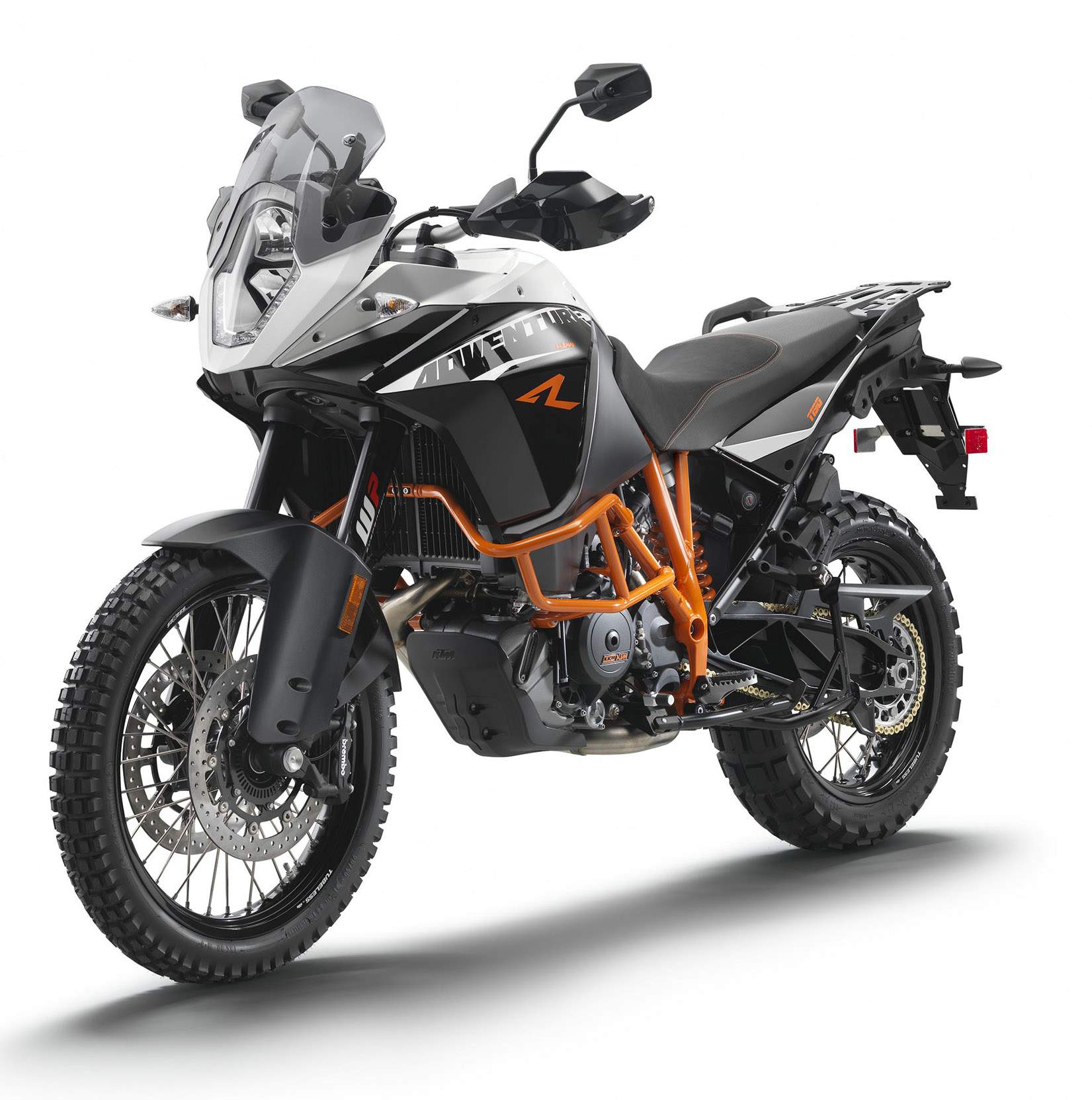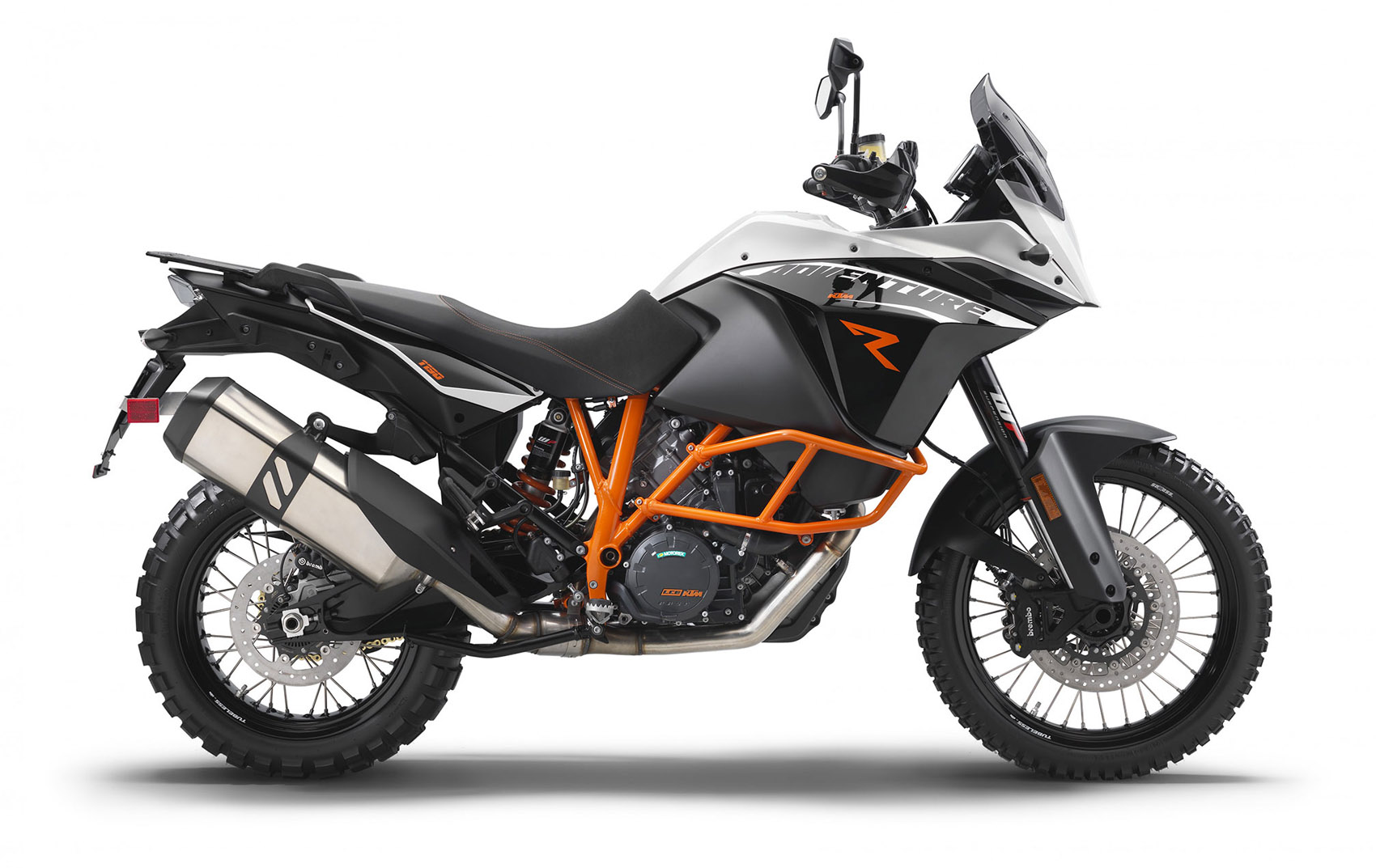Adventure bikes offer many things to their owners, but most of all they provide possibilities. While a large majority may never see the other side of the horizon or hardcore trails, they are capable of bringing true adventure to those willing to get out there and push the limits. Big-bore adventure motorcycles are the top of the ADV food chain and the BMW R1200 GS and KTM 1190 Adventure are the two baddest gorillas in the jungle. Yet there are even more extreme versions available from each marque – the R1200 GS Adventure and 1190 Adventure R – both of which are specially outfitted for serious travel off the beaten path. As soon as the GSA and Adventure R were announced debates raged online, and in the MotoUSA office, about which would be the ultimate mount for finding the end of the trail
BMW has offered an Adventure model of the GS for years, but fans had to wait a year for the water Boxer version. For 2014 BMW outfitted the R1200 GS Adventure with all of the updates on the new-for-2013 R1200 GS. The new water-cooled Boxer Twin, along with a host of electronic rider aids, ups the capability and usability of the GSA. On top of the new mill and tech updates, the GSA gets a massive 7.9-gallon fuel tank, more suspension travel and off-road friendly hardware such as handguards, crashbars and burly footpegs. Equipped with the premium package, olive green paint and aluminum panniers our test unit rings in at an MSRP of $23,463.
KTM took a huge leap forward in the big-bore ADV bike word when it introduced the 1190 Adventure. In our first ride review we said it was the best streetbike KTM has produced to date. But with the 1190 Adventure R the Austrian company is looking to dominate every area of the segment. Replacing the ever popular but sparsely appointed 990, the 1190 brings a massive power increase, sophisticated electronic rider aids and more comfort. Changes from the standard 1190 Adventure to the R model are crashbars, more suspension travel, increased ground clearance and a 21/18-inch wheel and tire set-up. The KTM 1190 Adventure R as equipped for our test with KTM Power Parts aluminum panniers and mounting hardware will cost you $18, 091.
As these are the most extreme examples of the biggest ADVmachines, we decided it would only be proper to scout out some legitimate off-road adventure, rather than just hitting the road from hotel to hotel and diner to diner. So instead we loaded up the bags with tents, sleeping bags, food, water and, of course, camera gear, and headed for the hills above Santa Barbara, California to find out what living with these two bikes on a real road trip would be like. Afterward, we spent two days in the mountains of Southern Utah for some additional seat time. Most of our miles were on dirt roads of varying quality, but we also hit the street and even pounded out a few hundred on the highway.
We also recorded some objective data with hard numbers such as curb weight, horsepower, torque and 0-60 acceleration. Subjective evaluations such as engine feel, suspension action and comfort carry equal weight on our scoresheet. We retained our standard comparison scoring, with a win in any category earning ten points and second-place getting eight. At the end we tally up the scores to declare a winner. And while the scoring helps suss out a ranking, this test was close almost too close to call. Both bikes excel in different ways, and depending on what is or isn’t important to you, readers may find removing a category will swing the results in either bikes favor. With that let’s get into the meat of this comparison.
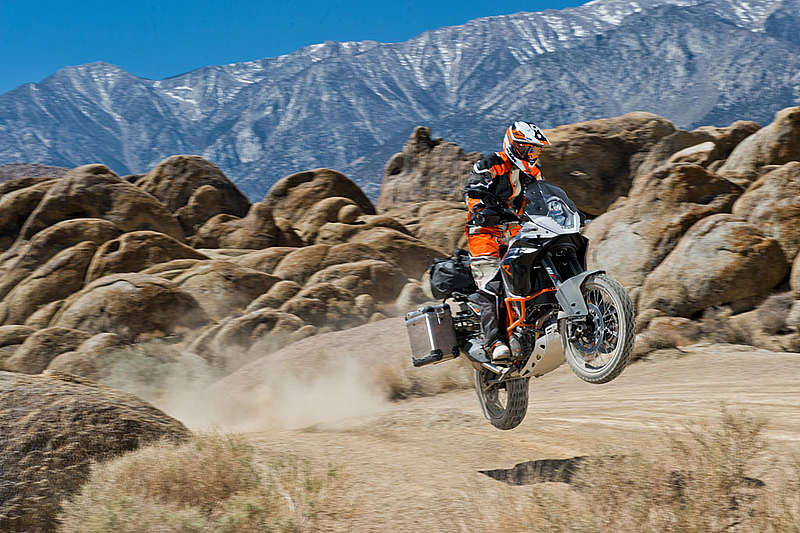
The BMW R1200GS is the yardstick by which all other large ADV motorcycles have been measured. Several brands that have come close to toppling the GS giant, but BMW has always won out in the end. While various rivals have individually trumped the Beemer on power, handling and styling, none have been able put it all together in a comprehensive package. And that is were the GS Adventure’s strength lies. It’s the king of all-rounders and epitome of the large-displacement ADV segment. And judging by the sales figures, buyers would agree, as the GSA is second only to the standard GS in global sales for BMW (with Adventure sales even with or slightly exceeding the standard GS in the U.S. market).
One look at the GSA and it’s obvious this bike is built to travel to faraway lands, and take a beating doing it. Crash bars, a massive front windshield and spoked wheels beg for rough terrain. It’s not a particularly good-looking motorcycle in the traditional sense, but more handsome like a bulldog – tough and rugged. Our test rider crew ranked it just below the KTM in looks, but beauty contests are not what the GSA is about. It’s about function. And function is what the GSA does. Its Flat Twin engine is a one of the best powerplants ever put in an ADV bike. The low-end torque pulls nicely on the street out of corners and chugs along on technical dirt roads. Your right wrist feels connected right to the crankshaft and power is easy to meter out. Up top the power is less impressive when compared to the 1190 Adventure R. While the power has increased from its oil/air-cooled predecessor, the water Boxer gets left in the dust by the upstart orange machine. On the MotoUSA dyno the BMW produced 105.07 peak horsepower, significantly less than the KTM (14 to be exact). However, the GSA just edged out the KTM in torque production with 76.25 lb-ft (a 0.93 lb-ft difference).
Those 105 rear-wheel ponies are more than enough to spin up the rear tire with less than perfect traction, but BMW’s five riding modes (Road, Dynamic, Rain, Enduro and Enduro Pro) keep things in control in just about any situation you can get yourself into. Ride mode adjusts traction control as well as ABS settings. On the street Road and Dynamic are all you need and work even with the factory optional TKC Continentals. In the dirt your two options of Enduro and Enduro Pro are a must. Enduro, which is calibrated for non-knobby tires, mellows out the power delivery and adjusts traction control to allow more wheelspin. Our default mode when we hit the dirt was Enduro Pro, which is tuned for knobby tires. The Enduro Pro throttle response is snappier, with the rear tire spinning up nicely. The rear ABS is also disabled in Pro, giving a dirt-savvy rider the utmost control available from the rider modes. The ABS works well in both settings and slows the GSA with control and authority. The traction control has a harder cutoff when it kicks in compared the KTM, and this put it just behind when riding full-tilt. Brakes on the BMW are strong and the ABS is excellent. Every ABS setting fits the riding mode perfectly, and not once did we feel the need to disable it completely. We appreciate the Enduro Pro setting, which allows the rear tire to lock up and slide when needed. Lever feel is consistent no matter the surface and has a connected feel with both street or dirt. So the brakes are excellent, but so are those on the KTM, and we ranked them even in the scoring.
On the street the GSA is the king of the corners. Its smaller diameter 19-inch front wheel offers more road confidence. With a more road-friendly tire profile (even with knobbies) the front turns into the bends with a linear feel. Combined with a lower center of gravity and more comfortable riding position the BMW’s handling had us playing rock-paper-scissor for who would get the GSA key on the street. When the dirt started it was the same game, but for who would not be on the BMW. In the dirt the heavier GSA proved less nimble and could only hope to hold onto the KTM’s dust. Suspension action was less plush and settled when the bumps appeared in any setting. On the BMW you just couldn’t push as hard on the trails as the KTM. The GSA could still go anywhere we wanted in the dirt, but it was more work and took longer. The KTM is better suited for aggressive off-road riders. Spending a total of five days in the saddle brings rider comfort to the forefront and the GS Adventure excels in this regard. A wide, flat seat offers plenty of support for pounding out the miles while the larger, more easily-adjusted windscreen better shields the rider from the elements. The GSA’s large footpegs are a huge upgrade over the standard units and the seat-to-peg distance is relaxed, making transition from sitting to standing easy. In just comfort alone the BMW is unrivaled in this comparison, but adding on the creature comforts like heated grips and cruise control puts it over the top.
If you have aspirations of 500-plus mile days, the BMW is the clear choice. Another big ADV plus for the GSA is fuel capacity and range. Throughout out test we recorded an average of 37 mpg. That is a quite a bit less than BMW claims of 55 mpg at 56 mph, but we didn’t always go that slow… We were very aggressive with the throttle, both on- and off-road, but with a 7.9-gallon fuel tank, the BMW still sports a range of nearly 300 miles (435 miles by BMW’s conservative speed estimate). The KTM’s 200-mile range isn’t even close. After tabulating the scoresheet, the 2014 BMW R1200 GS Adventure came up two points short of the KTM in this comparison. While it’s an official second-place, this is far from total defeat for the BMW. The GSA is the most comfortable touring platform and king on the asphalt. Depending or your adventure-touring needs, the GSA might be the clear winner. This comparison is almost too close to call.
KTM’s “ready to race” credo might not fit the ADV segment or the KTM 1190 Adventure R in the literal sense, but there’s no doubt the 1190 is one of the more extreme examples of an adventure-touring motorcycle. While you won’t be hitting the race course, you can feel and see the racing DNA in this hardcore ADV mount. The R model builds on the standard 1190 Adventure with more suspension travel, increased ground clearance and dirt focused wheel/tire combination. The R also sources crashbars and a smaller windscreen. Aggression is Adventure R’s game; a very different take on the segment compared to the BMW GSA.
Throw a leg over the 1190 Adventure R and the cockpit feels sparse in comparison to the GS Adventure. Creature comforts such as heated grips and cruise control are absent, and the windshield is miniscule compared to the BMW. Additionally the seat is thinner, resembling a large dirt bike unit. As the miles rolled on during our interstate blasts the decreased wind protection and less comfortable seat made it the less desirable of the two. Granted its nearly $5000 lower sticker price leaves plenty of leftover cash for farkles and comfort additions. But stock for stock, the GSA trounces the Adventure R in the ergonomics and comfort game. While it may not be the bee’s knees while pounding out the miles, twist the throttle and all is forgiven. While the GSA’s Boxer is stout, the 1190’s V-Twin is a monster. On the dyno the KTM blasted out 119.07 rear-wheel horsepower, 14 more than the GS. Just a tick behind the GS in the torque department, the 1190 put forth 75.31 ft-lb of torque. Get on the gas and the Adventure R rockets away from the BMW, with more horsepower and less weight, especially on the roll on. In our 0-60 test the KTM reached the mark one tenth of a second ahead at 3.1 seconds.
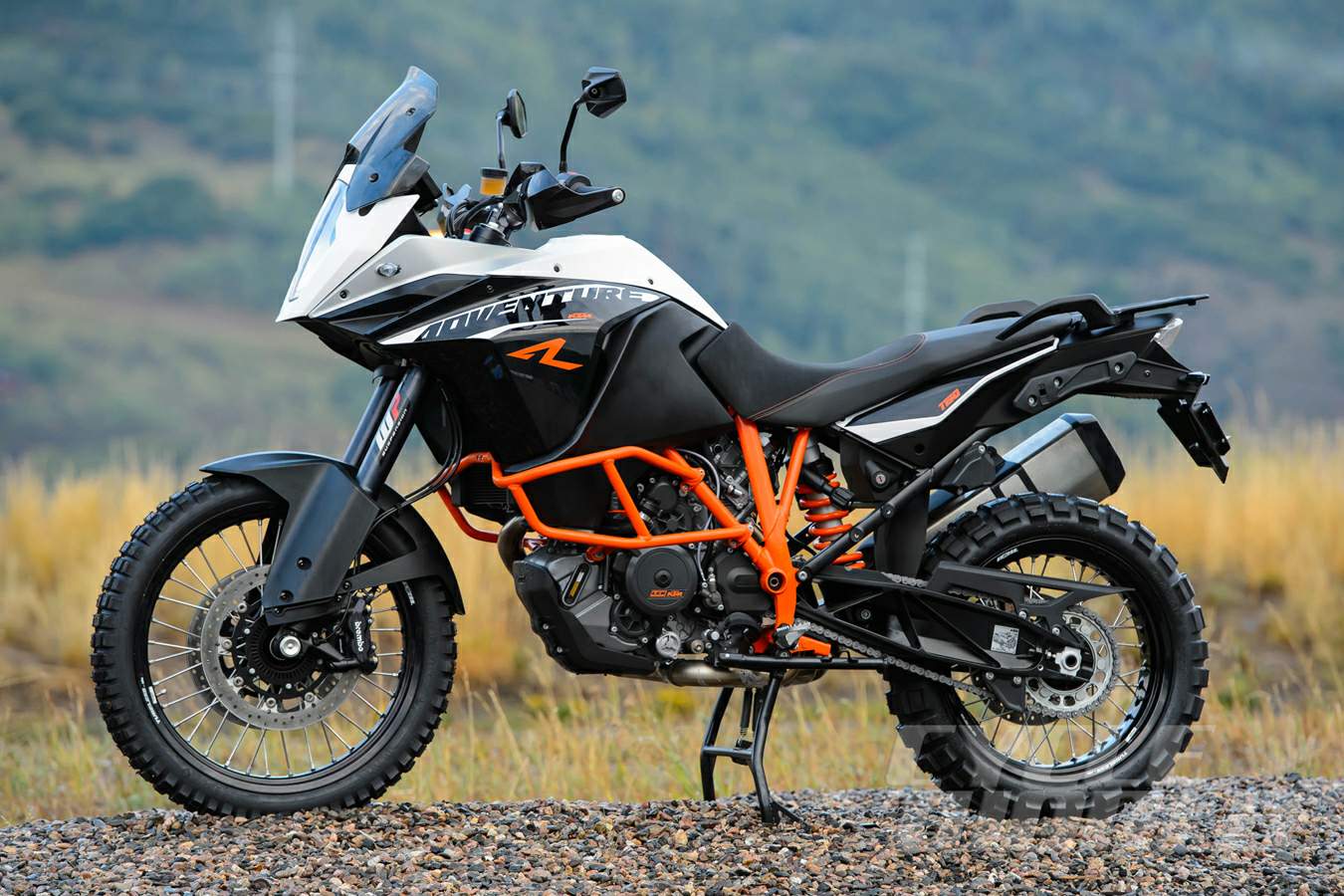
And the 1190 Adventure R puts the power to the ground well, on- or off-road. KTM’s traction control (MTC) is one of the most seamless we’ve ever tested and is the absolute best here. Four modes (Sport. Street, Rain and Off-road) meter the ride-by-wire throttle butterflies to temper the power dependent on wheel slip and lean angle. Sport mode lets the rear wheel spin up on the street before cutting the power back without any perceptible cut. Street mode keeps things in line while still allowing full power. Rain reduces the horsepower to a maximum of 100 at the crank and intervenes early. In the dirt the Off-road mode also reduces the power to 100 hp, but allows for plenty of wheelspin. Once the rear wheel speed doubles the front the MTC controls the power, but even so the effect is much less abrupt and noticeable in comparison to the BMW. You can just whack the throttle to the stop, let the rear end step out and drift like a champ. While you don’t have to shift much on the BMW, the KTM works better rowing through the gears to find the optimum ratio. This isn’t a problem as the ratios are spot on and shifts are solid, just not as solid as the BMW. The KTM’s clutch feel and engagement is much better, however, and this proved the difference in the transmission, clutch and gearing category.
The KTM’s suspension and handling off-road allow you to capitalize on the 1190’s excellent Off-road MTC settings. While the front and rear travel is nearly identical to the BMW, the more conventional upside-down forks have more feel and control over the GSA’s telelever frontend. There is much less hucking and bucking from the 1190 when the going gets rough. For dirt usage, the KTM is the boss in this contest. On the street, things aren’t as rosy. With a 21-inch front wheel, the front-end feel is less surefooted and confident, more like a dirt bike. As lean angles increase on curvey roads, the further the BMW pulls ahead. If you are a dirt junky and road work is just to get from trailhead to trailhead, the 1190 Adventure R is the best choice. One area the KTM does miss the mark as an ADV bike is the fuel range. During our testing the 1190 averaged 33 mpg. We were usually hard on the gas when we were anywhere but on the superslab thanks to the KTM’s awesome motor. We just wanted to feel the rush all the time; in return the fuel economy was well below the Beemer. With a smaller 6.1-gallon tank, the range is limited to just 201 miles. That falls well short of the rival BMW.
Braking power from the ABS-equipped Brembos is excellent with exceptional feel. One up the KTM has on the BMW in the braking department is the lean sensitive ABS, which does work well; the system is magic. If the R was equipped with a 19-inch front wheel it would destroy its German competition, but the 21-inch wheel with knobs doesn’t stop as hard or with as much feel on the front as the BMW. A better ABS system but less power, has us calling a draw in this contest. At the end of the test the KTM 1190 Adventure R squeaked out a win against the BMW R1200 GS Adventure. And that is a huge accomplishment. The BMW has been the gold standard for so long and even being on the same level is a win for any ADV machine. As we said before, this contest is almost too close to call, but the pure performance of the 1190 puts it over the top. If the adventure begins when the road ends, the KTM is our clear-cut winner.
Source Motorcycle USA
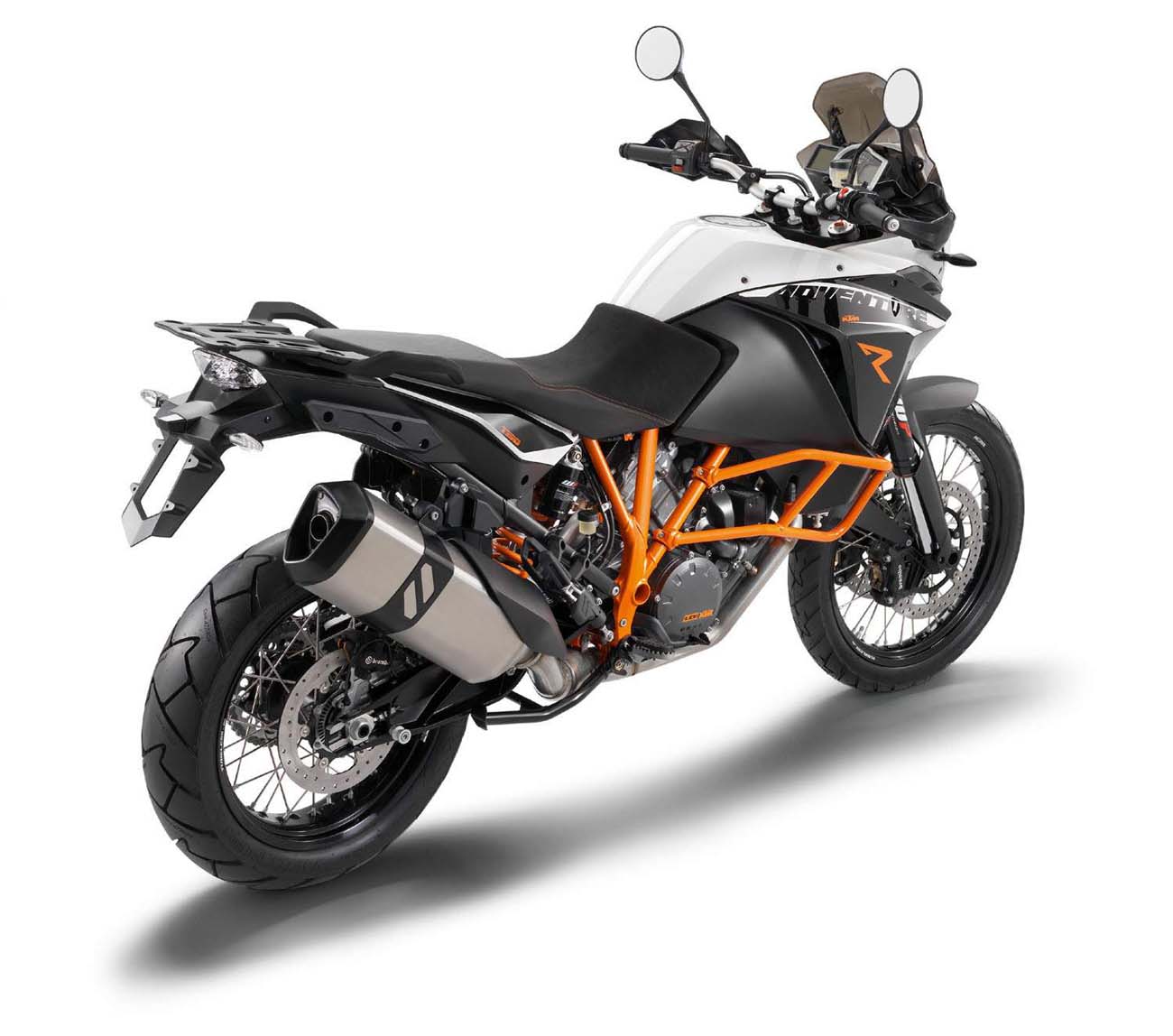
BMW R1200GS Adventure vs. KTM 1190 Adventure R- LONG-TERM
Well, you can’t have an adventure if you don’t venture off the beaten path, right? Dudek and Allen managed to get way off the grid near Huntington Lake, California, riding down a dead end trail that only pro-level tester and Baja 1000 first-in-class finisher Dudek could eventually ride back up. Allen said that without Dudek there to save the day and ride the GSA out for him, it would have required a hike for him and a helicopter ride for the BMW. The lesson? Mortals can get in too deep!
Well into testing, our 1190 Adventure became very hard starting and we discovered our bike’s engine had ingested a significant amount of dirt and dust that completely bypassed the air filter. A bit of research and contact with 1190 owners showed we were not alone in this phenomenon. KTM confirmed there was a flaw in the airbox/filter design (see Trip Notes), and warranty repairs for this issue took the 1190 out of circulation for the better part of a month, while the BMW marched on.
Once the KTM returned, we had to break in the new top end and get it back to the dealer for an oil/filter change before prepping the bike for a journey down the Baja California peninsula to celebrate New Year’s Eve in Mexico. Another set of Continental TKC80s (its third) were mounted on the KTM, while we finally got a set of Conti’s brand-new TKC70s ($415) to try on the BMW (see Trip Notes).
Although the planned route was originally supposed to take Allen, Dudek, and Dirt Rider Art Director Joe McKimmy to Cabo San Lucas primarily on asphalt, the trip, as with most of our journeys, included some detours that encompassed significantly more dirt than was originally intended. So the boys only made it as far as Loreto, about 700 miles south of Tecate on the east coast, and 300 miles short of Cabo.
On the return journey, it was once again the BMW’s turn for some drama. First, the GSA was tipped over in a concrete stream crossing, which was made slicker than ice by the unseen green slime under the surface. It got another QuikSteel patch on a cracked cylinder head cover (despite the stock crashbars). Next, its ESA rear shock blew out after hitting a washout at speed, forcing Allen to endure an undamped pogo-stick ride back to the US. Once home, the bike returned to Irv Seaver Motorcycles in Orange, California, for repairs. They discovered the front shock was also leaking, so both damping units were replaced under warranty. Further, the clutch finally called it a day and had to be replaced. At least with the newest boxer design, the clutch is mounted at engine’s front, no longer necessitating transmission removal as on previous versions. But parts cost was $1,458.46!
As for the KTM Adventure R, a few key aftermarket additions made the bike more comfortable off road and better able to endure the floggings we administered. Fasst Company’s Flexx Handlebars ($359.99; fasstco.com) and Simple Solution Handguards ($135.99) not only improve ergonomics while standing off road but also absorb harsh hits and reduce vibration to the hands, while the full-wrap guards offer maximum protection. Key to defending the KTM’s underbelly was AltRider’s skid plate ($394.97; altrider.com). This laser-cut, heavy-duty aluminum unit is incredibly sturdy and mounts to the KTM’s massive M10 engine bolts at the rear for extreme rigidity. Despite the plate’s burly nature, Dudek still managed to bend it, but it clearly saved the KTM from another calamity.
In regard to wear and tear, we smoked through a set of rear brake pads on each machine, largely due to our extensive off-road riding. Stock pads set us back $120.69 for the GS and $85.95 for the KTM. Other repairs that seemed pricey were the $65 brake lever for the KTM and a $400 horn button for the BMW. Yes, you read that right: After the Colorado crash, the GS’s little red horn button was dislodged from its housing. When in for service, a representative from Irv Seaver called to ask if I wanted them to replace the button. I said yes, but the button replacement entailed fitting a new left-side handlebar pod, which, with labor, tallied a totally ridiculous $448.10.
Nevertheless, of all the long-term bikes we’ve had over the past few years, none have proven as versatile, comfortable, and capable as these two. There are very few machines that can survive the constant abuse that these two endured, while still being able to hop on the freeway and comfortably knock out 1,000 miles as we did on our return from Colorado. In our time with them, we unearthed some of each machine’s faults, discovered many of their limits, and tested some of the best aftermarket products available.
Conclusions on this long-term comparison? For starters, both of these bikes were expensive as delivered, while maintenance and repairs proved high due to the amount of time spent off-highway. Maybe the average owner wouldn’t ride their $20,000 ADVs as hard as we did, but we’re here to push the limits. In that light, if off-road chops and raw performance are your most important purchasing decisions, the KTM is clearly the bike. It’s sportbike-fast on road and far better in technical dirt sections than any bike this big should be, all while being blessed with Bosch’s amazing lean-sensing ABS and traction control (see TECH ANALYSIS: Motorcycle Stability Control, Explained). But if total versatility and long-haul comfort are more important to you, then the BMW is hard to fault. It offers supreme on-road manners, went everywhere the KTM did (though was much more challenging in the hard stuff), and has more available convenience and creature-comfort features. Every tester called it incredibly close, and the choice really came down to the projected use. Bottom line? Modern big-bike adventure isn’t cheap (and we’re sure glad there are good warranties), but it’s sure worth it.
SPECIFICATIONS
|
|
BMW R1200GS Adventure |
KTM 1190 Adventure R |
|---|---|---|
|
|
|
|
|
TOTAL MILES |
11,064 |
11,837 |
|
NEXT SERVICE |
18,000 |
18,600 |
|
MAINTENANCE COSTS |
$1,858.98 |
$1,641.95 |
|
REPAIR COSTS |
$3,173.87 |
$230 |
|
AVERAGE FUEL MILEAGE |
39 mpg |
40 mpg |
|
PRICE AS TESTED (2014) |
$21,671 |
$18,134 |
|
CURRENT BLUE BOOK VALUE |
$17,395 |
$13,600 |
FROM DUST TO GORY
There has been a lot of buzz about the KTM 1190/1190 R’s airbox ingesting dust and dirt during extensive off-road riding. The fact that the KTM’s second scheduled service interval wasn’t until 9,300 miles—and that access to the air filter requires laboriously removing the fuel tank—kept us from catching the issue any earlier.
While on our Adventure Rally in California last September, Ryan Dudek began experiencing hard starting (due to tight valves), which led him to remove the tank and airbox cover to discover that the throttle body mouths were coated in dust and grime. With 8,020 miles on the clock, the KTM was taken to Orange County KTM to diagnose the issue. Despite a completely clean air filter, enough dirt, sand, and dust had been ingested to destroy our R’s top end.
This is clearly a flaw in the airbox’s design, and KTM repaired our 1190’s engine under warranty.
A complete top-end rebuild included: cylinders, pistons/rings, valve kit, base gasket, head gasket, valve collets, spark plugs, valve cover gasket, and head bolts/washers. To prevent future damage in similar riding conditions the dealer installed KTM’s Dust Protection Kit (part #60306922000, $64.79), consisting of a pair of fairing-intake-snorkel inserts that have a mesh fabric stretched over them as a first defense. Also, a better-sealing, high-performance DNA air filter (DNA part #P-KT12E13-01, KTM part #603 06 115 000, $124.99) was installed.
The lesson here: If you ride either version of the 1190 off-road in dusty conditions on a regular basis, upgrade to these better lines of defense and check your air filter frequently. If you let it vacuum up half of the Baja 1000 course as we did and have experienced issues, get it into your KTM dealer for repairs before your warranty expires.
TIRES, TIRES, AND MORE TIRES
Big adventure bikes have an insatiable appetite for rubber. Each machine is on its fifth set of tires (including the stock sets). Due to the significant number of off-road miles, knobbies have won the day. After trying out Kenda’s (kendatire.com) Big Blocks (which were great in the dirt but not so grippy on road), we returned to our favorite ADV tire, Continental’s (conti-online.com) TKC80. Not only do these tires bring out the very best in these bikes off highway—clawing for traction in Mexican silt, climbing up slickrock faces in Utah, plowing through boulder gardens in Colorado, and hopping over tree roots in the Sierras—but they work well on asphalt too. They are easily the single best performance modification you can make to a big ADV machine. The shortest life we recorded on a set of TKC80s was less than 1,000 miles, while our best was almost 3,000. For the New Year’s journey into Baja, we mounted up Conti TKC70s on the GSA. Jeff Allen was impressed with their overall performance but felt a knobby front was well warranted for the peninsula’s ample sand and silt (we will definitely be trying a TKC70/80 cocktail soon). But for now we’re curious to see how many miles we can get on the 70s before our bike gets repo’d.
FROM THE LOGBOOK
Blake Conner: The single most memorable moment for me with these two bikes was when Dudek and I rode the Slickrock Trail in Moab, Utah. At the time, I fully understood that we were doing something that few others would attempt on such big machines, especially with such major consequences for a mistake (250- to 500-foot cliffs!), and, stupidly, we had the bags attached. But we survived. It wasn’t until I went back on a KTM Freeride 250 R and rode the trail again that I fully grasped how insane we (at least me) were to ride ADVs there.
Jeff Allen: Just the sight of either of these bikes gets the road-trip part of my brain firing. Baja, ADV Rally, Yosemite, Baja again, 1,000-mile three-day weekend? No problem. A 2,500-mile weeklong ride? Even better. I wish the bikes would stay around a lot longer; I still have plans swirling around in my head. At around 600 pounds each, both bikes demand respect off-road. At the same time, they work so well in the dirt it’s easy to forget they’re not dirt bikes. In sand or when trying to get them stopped in the dirt, you are quickly reminded of their size. Give them the respect they deserve. That stated, these are great tourers with good wind protection and rugged luggage. Highway 1 to Oregon anyone? The wife will worry you’re never going to come home. It’s a real possibility.
Joe McKimmy: I prefer the seat height on the Beemer for my short, stumpy legs. With a 600-pound motorcycle, it’s nice to know you have more than a toe touching to keep your balance in awkward spots. For me, the KTM is much more comfortable off road, able to plow through square-edged chop and big bumps with ease. I think the 21-inch front wheel makes a big difference on the rough stuff. But I am really quite surprised how well the BMW handles over loose rock sections. The wide tires allow the bike to be really stable.
Source cycleworld.com

